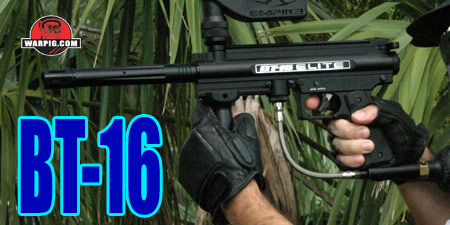  |
|
|
|
|
|
|
  |
|
|
|
|
|
|

What
do you think?
|

BT-16 Elite By Bill Mills - Photos By Dawn Mills - Sept 2005 Overview - How it Works - Disassembly - Testing - Raw Test Data How it works The BT-16 is a blowback driven semi-auto. When it is at rest, between shots, the bolt is open, and a ball is sitting in the breech. The ball detent prevents the ball from rolling forward into the barrel and double feeding or chopping the next ball. The sear, a piece of hardened steel which projects up into the bottom of the receiver from the grip frame is a latch which holds the hammer back, keeping the mainspring behind it compressed. When the trigger is pulled, a ledge on the back of the trigger pushes upward on the front of the sear. The sear then pivots on the sear pin, rather like a see-saw, until its back end comes down far enough that it releases the hammer.
Once the hammer is free, the mainspring drives it forward toward the valve. This slides the linked bolt forward, pushing the ball into the back of the barrel. The valve consists of an aluminum cylinder called the valve tube, inside a plastic valve body which fits over it like a sleeve. The bolt itself is hollow, and it slides forward on the hollow power tube, which extends from the front of the BT-16’s valve body. The tube acts as a conduit for gas to flow from the valve, through the center of the bolt, and into the breech, firing the ball. The bolt has an o-ring near its front edge, to seal the breech.
The hammer presses on the pin, which pushes the valve seal away from its seat, and compresses the valve spring. This allows gas which feeds into the valve to be released in two directions. A portion of the gas flows around the sides of the valve, through channels in the inner aluminum valve tube, around to the front of the valve body, into the power tube, and ultimately through the bolt, firing the paintball. A screw protrudes through the side of the valve body, partially blocking the flow of gas into the power tube. The head of this screw is accessible a hole in the right side of the BT-16’s receiver. Screwing the adjuster inward blocks more gas flow, reducing velocity, while screwing it outward blocks less flow, increasing velocity.
In addition to flowing forward, some of the gas released by the valve flows back towards the hammer. The hammer, fitting into the back of the valve body forms a piston, so the gas pressure inside forces the hammer backwards, out of the valve body. As the hammer flies back it pulls the bolt back also, and pushes the top of the sear backwards, disengaging the front of the sear from the trigger. The hammer’s rearward movement is stopped by a bumper in the form of an o-ring against the back plug of the receiver. It then moves slightly forward where it catches on the back of the sear again. When the hammer is off the valve, a combination of valve spring pressure and gas pressure on the back side of the valve core close the valve. At this point, the mainspring is compressed, the hammer is locked up on the sear, the bolt is back, and a fresh paintball falls into the breech, ready for the next shot. The BT-16’s valve is built to handle CO2 well. Because gas pressure pushes against the valve seal, the valve can compensate to a degree, for fluctuations in gas pressure. When gas pressure is higher, the hammer will face more resistance in opening the valve, and thus will not open it as far or as long, releasing less gas. When pressure is lower, the valve is opened further with each shot, letting through more gas. >Continue to Disassembly |
| Copyright © 1992-2019
Corinthian Media Services. WARPIG's webmasters can be reached through our feedback form. All articles and images are copyrighted and may not be redistributed without the written permission of their original creators and Corinthian Media Services. The WARPIG paintball page is a collection of information and pointers to sources from around the internet and other locations. As such, Corinthian Media Services makes no claims to the trustworthiness or reliability of said information. The information contained in, and referenced by WARPIG, should not be used as a substitute for safety information from trained professionals in the paintball industry. |